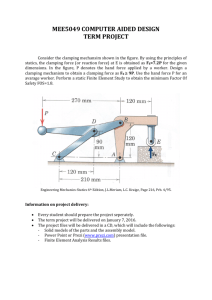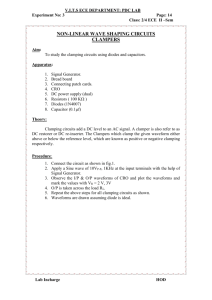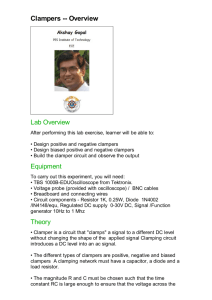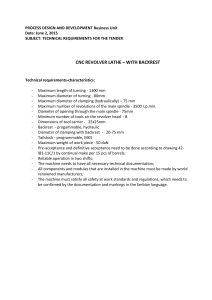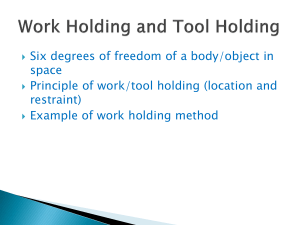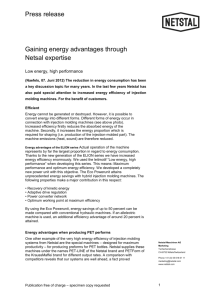Document 13135619
advertisement
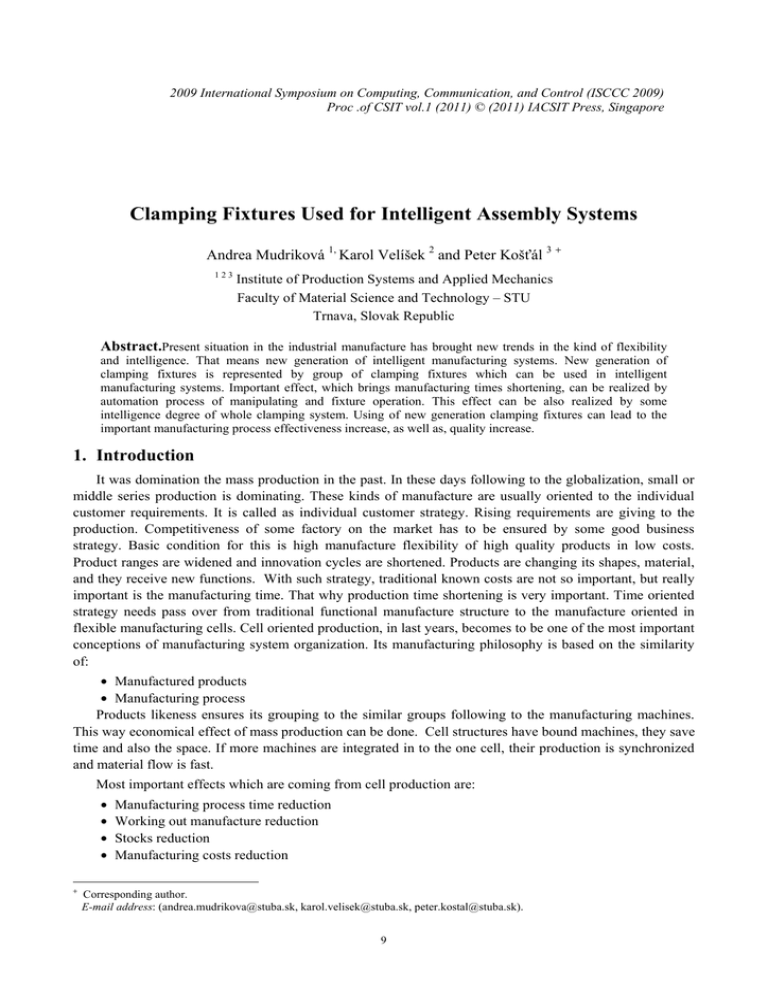
2009 International Symposium on Computing, Communication, and Control (ISCCC 2009) Proc .of CSIT vol.1 (2011) © (2011) IACSIT Press, Singapore Clamping Fixtures Used for Intelligent Assembly Systems Andrea Mudriková 1, Karol Velíšek 2 and Peter Košťál 3 + 123 Institute of Production Systems and Applied Mechanics Faculty of Material Science and Technology – STU Trnava, Slovak Republic Abstract.Present situation in the industrial manufacture has brought new trends in the kind of flexibility and intelligence. That means new generation of intelligent manufacturing systems. New generation of clamping fixtures is represented by group of clamping fixtures which can be used in intelligent manufacturing systems. Important effect, which brings manufacturing times shortening, can be realized by automation process of manipulating and fixture operation. This effect can be also realized by some intelligence degree of whole clamping system. Using of new generation clamping fixtures can lead to the important manufacturing process effectiveness increase, as well as, quality increase. 1. Introduction It was domination the mass production in the past. In these days following to the globalization, small or middle series production is dominating. These kinds of manufacture are usually oriented to the individual customer requirements. It is called as individual customer strategy. Rising requirements are giving to the production. Competitiveness of some factory on the market has to be ensured by some good business strategy. Basic condition for this is high manufacture flexibility of high quality products in low costs. Product ranges are widened and innovation cycles are shortened. Products are changing its shapes, material, and they receive new functions. With such strategy, traditional known costs are not so important, but really important is the manufacturing time. That why production time shortening is very important. Time oriented strategy needs pass over from traditional functional manufacture structure to the manufacture oriented in flexible manufacturing cells. Cell oriented production, in last years, becomes to be one of the most important conceptions of manufacturing system organization. Its manufacturing philosophy is based on the similarity of: • Manufactured products • Manufacturing process Products likeness ensures its grouping to the similar groups following to the manufacturing machines. This way economical effect of mass production can be done. Cell structures have bound machines, they save time and also the space. If more machines are integrated in to the one cell, their production is synchronized and material flow is fast. Most important effects which are coming from cell production are: • • • • + Manufacturing process time reduction Working out manufacture reduction Stocks reduction Manufacturing costs reduction Corresponding author. E-mail address: (andrea.mudrikova@stuba.sk, karol.velisek@stuba.sk, peter.kostal@stuba.sk). 9 • • • • • • • Rigid reaction ability to the market requirements Higher machine usage Redistributing times reduction Quality increase Material and manufacturing documentation circulation reduction Stock material volume reduction Manufacturing space reduction 2. Flexible manufacturing system Flexible manufacturing system (FMS) is one or more technological devices with system realizing its basic functions in some automatic run. This system is able to flexible react to the product range change. Some new art have to belong to some group of similar products. Some dimension similarity has to be realized. Also type of parts in some group has to be similar. Then in such group is the flexible manufacturing system able to flexible react to some changes in the manufacturing process. System is able to manufacture new kinds of product after some information change. Manufacturing and other helping devices can not be specialized or one purpose. These kinds of flexible manufacturing systems are usually used in repeatable manufacture with often product range change. Flexible Manufacturing System is integrated and with computer operated complex of numeric controlled machines and automated manipulating devices, which are operating with material or tools. Such integrated system is able manufacture every part with minimal human interventions and minimal trial operations. This system is able to manufacture only such part, which belongs to some specific well organized and planned part group. Flexible manufacturing cell structure is usually taken us some group of manufacturing technique on some specific space or volume. In this volume or space are realized most of all technological operations. These operations are made on manufacturing objects with less manipulation. High flexibility degree is accessible what leads to the integration with semi operating transport with higher control degree. [2]. Flexibility is usually shown as • Adaptive ability • Adaptive speed ability To the basic FMS elements belongs: • Manufacturing NC and CNC devices • Devices used for semi operating transport and manipulation, which are realizing automated feeding of machines with parts on input and also on output, • To the operating transport system, which is based by special devices and manipulators, • Parts and tools carriers. The problem with fixture and placement of tools is solved, • Sensing and blocking elements, which are using for sensing and monitoring of the system, • Control systems, which are realizing run of whole manufacturing device. FMS has to realize these basic three operations: • manufacture – whole technological process belongs to this operation, • sorting – to this operation belongs precision control. This phase is also sometimes known as manufacturing quality control. Also monitoring and diagnostic belongs to this degree, • transport and storage – solving of storage volume, transporting ways for tools, parts, measure devices and other supporting parts, which are needed for manufacturing process. Flexibility of FMS is given by some parts properties. Basic elements of flexible assembly and manufacturing cells are machines with non changeable program and flexible adaptation ability to the given program. Such manufacturing and assembly devices are named robotic manufacturing cell, with central element an industrial robot. Four, five or six freedom degrees robots are used, and they are realizing these basic tasks: • assembly devices controlling the cell – using of simple operation with using of modular robots and manipulators, 10 • assembly systems which are creating assembly centres with high concentration of technological, manipulating, assembling and helping functions on one place, • assembly systems, which are able to realized technological and assembly operations. These operations are realized only by industrial robot of higher generation. In flexible manufacturing and assembly systems is expectation of high manufacturing program flexibility and that why using of so called intelligent manipulating and clamping devices is realized. The aim of such intelligent manipulating and fixture devices is, that every flexible manufacturing and assembly cell is designed for flexible manufacture, what means, that such manufacture is some manufacturing program alternative. So every one product which is manufactured or assembled by such cell has its own clams used for his positioning and clamping. After automated modification of positioning and fixture device, the control system knows what degree of power can be used for clamping. Such information are for control system stored in the database. [1]. 3. Intelligent assembly cell Project of intelligent manufacturing cell based at the laboratory at institute of manufacturing systems and applied mechanics at the faculty of material science and technology of Slovak university of technology. Building of model flexible integrated manufacturing and assembly system used for piece production or low series production is representing new philosophy in design of complex production. Such progress represents flexible manufacturing system, which is manipulating with single parts for concrete final products, which are assembled at the process ending. This system is different from present manufacturing and assembly systems by that, in his working space the final product are assembled. Final product is here assembled of semi products and products which are manufactured by the same system. Of course some parts are incoming from the system environment. An important innovation degree of such solution is, that for manipulation and assembly is not used some external industrial robot. System is able to react to the manufacturing requirements changes. Whole system is composing of two working units. One unit is representing by Cartesian robot Figure 1 and other one unit is shelf storage system. These two units are reconnected by rotary feeding device. Figure 1 Cartesian robot Changes in the manufacturing process. System is able to manufacture new kinds of product after some information change. Manufacturing and other helping devices can not be specialized or one purpose. These kinds of flexible manufacturing systems are usually used in repeatable manufacture with often product range change. Flexible Manufacturing System is integrated and with computer operated complex of numeric controlled machines and automated manipulating devices, which are operating with material or tools. Such integrated 11 system is able manufacture every part with minimal human interventions and minimal trial operations. This system is able to manufacture only such part, which belongs to some specific well organized and planned part group. Flexible manufacturing cell structure is usually taken us some group of manufacturing technique on some specific space or volume. In this volume or space are realized most of all technological operations. These operations are made on manufacturing objects with less manipulation. High flexibility degree is accessible what leads to the integration with semi operating transport with higher control degree. [2]. Flexibility is usually shown as • Adaptive ability • Adaptive speed ability To the basic FMS elements belongs: • Manufacturing NC and CNC devices • Devices used for semi operating transport and manipulation, which are realizing automated feeding of machines with parts on input and also on output, • To the operating transport system, which is based by special devices and manipulators, • Parts and tools carriers. The problem with fixture and placement of tools is solved, • Sensing and blocking elements, which are using for sensing and monitoring of the system, • Control systems, which are realizing run of whole manufacturing device. FMS has to realize these basic three operations: • manufacture – whole technological process belongs to this operation, • sorting – to this operation belongs precision control. This phase is also sometimes known as manufacturing quality control. Also monitoring and diagnostic belongs to this degree, • transport and storage – solving of storage volume, transporting ways for tools, parts, measure devices and other supporting parts, which are needed for manufacturing process. Flexibility of FMS is given by some parts properties. Basic elements of flexible assembly and manufacturing cells are machines with non changeable program and flexible adaptation ability to the given program. Such manufacturing and assembly devices are named robotic manufacturing cell, with central element an industrial robot. Four, five or six freedom degrees robots are used, and they are realizing these basic tasks: • Assembly devices controlling the cell – using of simple operation with using of modular robots and manipulators, • Assembly systems which are creating assembly centres with high concentration of technological, manipulating, assembling and helping functions on one place, • Assembly systems, which are able to realized technological and assembly operations. These operations are realized only by industrial robot of higher generation. In flexible manufacturing and assembly systems is expectation of high manufacturing program flexibility and that why using of so called intelligent manipulating and clamping devices is realized. The aim of such intelligent manipulating and fixture devices is, that every flexible manufacturing and assembly cell is designed for flexible manufacture, what means, that such manufacture is some manufacturing program alternative. So every one product which is manufactured or assembled by such cell has its own clams used for his positioning and clamping. After automated modification of positioning and fixture device, the control system knows what degree of power can be used for clamping. Such information are for control system stored in the database. [1]. 4. Intelligent assembly cell Project of intelligent manufacturing cell based at the laboratory at institute of manufacturing systems and applied mechanics at the faculty of material science and technology of Slovak university of technology. Building of model flexible integrated manufacturing and assembly system used for piece production or low series production is representing new philosophy in design of complex production. Such progress 12 represents flexible manufacturing system, which is manipulating with single parts for concrete final products, which are assembled at the process ending. This system is different from present manufacturing and assembly systems by that, in his working space the final product are assembled. Final product is here assembled of semi products and products which are manufactured by the same system. Of course some parts are incoming from the system environment. An important innovation degree of such solution is, that for manipulation and assembly is not used some external industrial robot. System is able to react to the manufacturing requirements changes. Whole system is composing of two working units. One unit is representing by Cartesian robot Figure 1 and other one unit is shelf storage system. These two units are reconnected by rotary feeding device. Figure 2 Shelf storage systems Figure 3 System assembly cell Intelligence degree of assembly cell will be assigned by sensor equipment and also whole control system. The aim of this is reaching of flexible reaction to the manufacturing requirements, which will be given in to the device as input data. 5. Fixture systems Fixtures research at the institute of manufacturing systems and applied mechanics at faculty of material science and technology at Slovak university of technology. At the institute a research is realized, which deals about design and usage of new generation clamping fixture. With analysis of knowledge Clamping systems One of productivity hinges possibility is shortening of limited manufacturing times. Main effect of such time shortening can be done by automation process of clamping and manipulating operation. Design process of clamping fixtures is in these days very had job, which needs many experiences of technologist and also designer. Not correct clamping can be the main reason of manufacturing error. The labour is usually clamping all products to the clamping fixtures by some practical experiences. By using of other one labour by clamping of the same product, some other kind clamping can be realized. This error will be shown at the manufacturing incorrectness. This bad influence can be deleted by using of automated clamping systems. [4] 13 Important element of operation automation is full remove of labour from the manufacturing process. This target can be done by intelligence increase of whole manufacturing device, and this way also its clamping fixture. Expected advantages: • Labour influence elimination, so the clamping precision will be increased, • Clamping cycle automation, limited times shortening, manufacturing effectiveness increase, • Clamping system monitoring, can prevent of the collision stays during the manufacturing process. Intelligent fixtures are in present days mostly used in robotized manufacture, in assembly, which seams as the most important operation. Robots are characterized by huge automation degree. Tools, fixtures and measure devices are usually operated in automated run. That means, such devices has except of their power unit (hydraulic, pneumatic, electric), also one control unit. Labour monitoring is replaced by using of sensors. Such sensor control will lead to the some degree of intelligent clamping and fixture. Intelligent fixtures are offering also other function such as: • Clamping power control, clamping torques control, • Clamping operation monitoring with help of sensors, sensing of powers, torques or pressures, • Other special purpose functions such as automated clamps changing system, automated tool changing systems and so on. Intelligent fixtures become to be very important part of manufacturing process in intelligent manufacturing systems. Manufacturing process in such systems is fully automated and single intelligent fixtures are realizing these functions: • • • • • • • • • • Workpiece positioning, Workpiece clamping, Clamping power control, clamping torques control, Clamping operations monitoring, Other special purpose functions such as automated clamps changing system, Clamping power can be regulated, Only one possible position in the fixture, High and repetitive clamping precision, High clamping stiffness, Simple operation of automated clamping cycle. Figure 4 Pneumatic clamping system Sensor equipment of intelligent fixture Pneumatic driven fixture will be equipped by sensors, which will sense, clamps presentence, part presentence in the fixture body, clamps position or clamping power. According to the small pneumatic driven fixture dimensions we have also chosen sensors with small dimensions. Important are also conditions such as price, simple assembly to the fixture body, simple design and so on. With using of sensors at pneumatic driven fixture, we will achieve automated driven manufacturing process without labour influence. Manufacturing productivity and manufacturing quality will 14 increase. Also whole manufacturing costs will fall down. To create such solution is very important to solve communication between sensors and control unit. Sensors in intelligent fixtures Sensors are working at principle of sensing elements integration such as analogical and number transducer and microprocessor on one chip. These sensors are allowed signals, which are in some way cleaned from environment influences. They are able to offer also complex information taken by evaluation of many signals such as. Sensor intelligence consider in: • Diagnosis of sensor status and error, • Adapt speed to the change in measured group, • To the intelligence degree consider also program equipment, which is non breakable part of sensor evaluate unit, • Communication ability in some sensor net. Figure 5 CAD model of pneumatic clamping system equipped by sensors 6. conclusion Using of sensor equipment on the clamping fixture will lead to the cooperation of the fixture with the control system of whole flexible assembly cell. This clamping fixture has to satisfy requirements such as simple design, safety, reliability, and wide clamping range. Very important are also requirements such are non complicated maintenance and operation as well as long lifetime and minimal dimensions. 7. Acknowledgements This paper was created thanks to the national grants VEGA 1/0206/09 – Intelligent assembly cell This paper was created thanks to the national grants 8. References [1] Velíšek, Karol - Košťál, Peter: Self organizing manufacturing cell philosophy. In: Scientific Bulletin. - ISSN 1224-3264. - Vol. XXI / nadát. International Multidisciplinary Conference. 7th. Baia Mare, Romania, May 1718, 2007 (2007). - Baia Mare: North University of Baia Mare, 731-734, II. diel [2] Horváth, Štefan - Danišová, Nina: Power elements of flexible manufacturing and assembling systems. In: International doctoral seminar: Proceedings. Smolenice, May 18-20, 2008. - Trnava: AlumniPress, 2008. - ISBN 978-80-8096-058-2. - S. 130-136 [3] Velíšek, Karol - Javorová, Angela - Zvolenský, Radovan - Danišová, Nina - Košťál, Peter: Multifunctional manufacturing and assembly system. In: Development of Mechanical Engineering as a Tool for Enterprise Logistics Progress: Science Report Project CII-PL-0033-01-0506. - Poznaň: University of Technology, 2006. ISBN 83-89873-28-1. - S. 135-158K. Elissa, “Title of paper if known,” unpublished. [4] Charbulová, Marcela - Pecháček, František: Modular clamping systems. In: RaDMI 2007: Proceedings on CDROM of 7th International Conference "Research and Development in Mechanical Industy - RaDMI 2007", Belgrade/Serbia/, 16-20 September 2007. - Trstenik: High Technical Mechanical School of Trstenik, 2007. - ISBN 86-83803-22-4. - S. 149-153 [5] Zvolenský, Radovan - Javorová, Angela: Flexible manufacturing and assembly cell with automated tool changing system. In: RaDMI 2006: Proceedings on CD-ROM / nadát. International Conference. Budva, Montenegro, 1317.Sept. 2006. - Trstenik: High Technical Mechanical, School of Trstenik, 2006. - ISBN 86-83803-21-X. - S. 1-6 15
